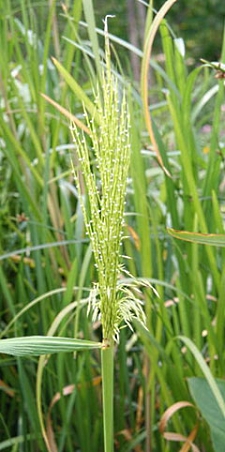Wildlife - Species

Wild Rice (Zizania aquatica)
Description
Wild rice belongs to the grass family (Poaceae), and is an aquatic grass. The species is a perennial (lives for many years) grass in the South and an annual (plant dies each year) in the North and West. The plant is 1-4 m (3-12 ft) tall, and the stems are thick and spongy. The leaves are long, flat, and wide, and they have finely sharp-toothed margins. The species is monoecious, and male and female flowers appear on the same panicles (flowering stems). The panicles are large and terminal (at the apex of the plant). The lower branches of the panicles are pendulous, and the upper branches are stiffly ascending.
Preferred Habitat and Biology
Wild rice is found from Quebec, Canada, to Florida and west to Texas and North Dakota. Populations of this grass are also found in Idaho and Arizona. Wild rice inhabits freshwater marshes and quiet waters of streams. In the ACE Basin, it grows in abandoned rice fields and tidal freshwater and brackish marshes. Wild rice thrives in shallow water, where the bottom is mucky or silty, and there is enough water circulation to provide sufficient oxygen for growth.
Wild rice grows vegetatively for a relatively long period (April-September). In July, flowers emerge and are pollinated. Seeds mature over the next two months. Wind disperses mature seeds throughout the marsh, where they remain dormant during the winter and germinate the following spring. By late August, vegetative growth and sexual reproduction cease.
Species Significance
In South Carolina, wild rice seeds are a favorite food of ducks, rails, blackbirds, and bobolinks. They are considered an excellent duck food. Wild rice is common throughout its range, and it has been planted with great success in many areas outside its native range.
References
Godfrey, R.K. and J.W. Wooten. 1981. Aquatic and wetland plants of southeastern United States: Dicotyledons. The University of Georgia Press, Athens, GA.
Martin, A.C., H.S. Zim, and A.L. Nelson. 1951. American wildlife and plants: A guide to wildlife food habits. Dover Publications Inc., New York, NY.
Odum, W.E., T.J. Smith, III, J.K. Hoover, and C.C. McIvor. 1984. The ecology of tidal freshwater marshes of the United States east coast: A community profile. Report No. FWS/OBS-83/17. U.S. Department of the Interior, Fish and Wildlife Service. Washington, DC.
Porcher, R.D. 1995. Wildflowers of the Carolina Lowcountry and lower Pee Dee. University of South Carolina Press, Columbia, SC.
Whigham, D. and R. Simpson. 1977. Growth, mortality, and biomass partitioning in freshwater tidal wetland populations of wild rice (Zizania aquatica var. aquatica). Bulletin of the Torrey Botanical Club 104(4):347-351.
